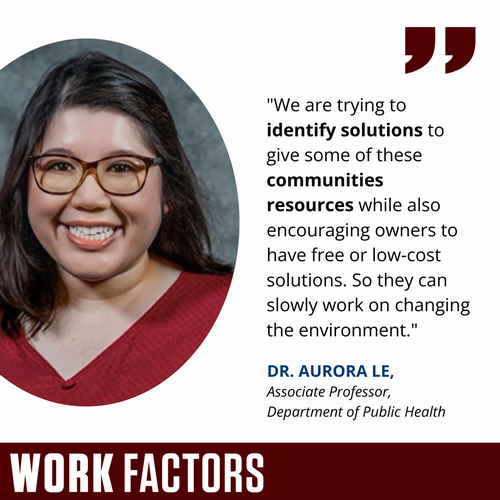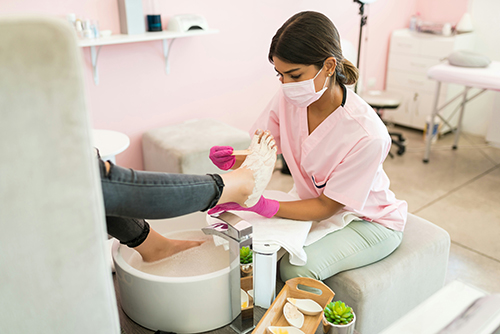Occupational Health Disparities
Occupational Health Disparities
“Nail salon workers are emblematic of low-wage, immigrant women in the service industry who are largely invisible to the communities they service.” – Dr. Le
Occupational health disparities are found in various industries, including nail salons, custodial services, food service, and solid waste management. Dr. Aurora Le conducts research on occupational safety and health interventions for these workers, focusing on perceived stressors, health issues, and effective interventions.
 In her study of Michigan nail salons, Dr. Le found that over half had disciplinary actions for unlicensed and illegal activities, putting both workers and customers at risk. Nail salons are a multi-billion-dollar industry employing between 126,000 and 212,000 workers, mostly immigrant women of Southwest Asian descent. These workers are exposed to toxic chemicals, ergonomic hazards, and infectious agents. Salon work has been linked to respiratory, dermal, endocrine, and reproductive problems. 1
In her study of Michigan nail salons, Dr. Le found that over half had disciplinary actions for unlicensed and illegal activities, putting both workers and customers at risk. Nail salons are a multi-billion-dollar industry employing between 126,000 and 212,000 workers, mostly immigrant women of Southwest Asian descent. These workers are exposed to toxic chemicals, ergonomic hazards, and infectious agents. Salon work has been linked to respiratory, dermal, endocrine, and reproductive problems. 1
While in Michigan, Dr. Le formed a community-based participatory research plan that involved researchers working alongside nail salon owners and workers. The group created educational materials and assessed their effectiveness, aiming to promote the health and safety of the workers.
Dr. Le also researches the health and safety of workers employed in solid waste removal and those who manage human remains. Nearly 500,000 workers are classified as “Waste Management and Remediation” workers by the U.S. Bureau of Labor Statistics. Waste workers have higher injury and illness rates compared to workers across all private industries, with total recordable case rates of 3.1 vs. 2.7 per 100 full-time workers, respectively. 2

Workers in both waste management and decedent remains handling come into contact with sharps, feces, bodily fluids, and bloodborne pathogens. Dr. Le researches best practice training techniques to help workers perform their jobs safely and avoid contracting infectious diseases.
By unveiling these disparities and advocating for proactive measures in these important but often overlooked occupations, Dr. Le’s work sheds light on these issues to help ensure the well-being of these vulnerable occupational groups.
You can hear more these important initiatives and research in the Work Factors podcast featuring Dr. Le. For more information on Occupational Health Disparities Research, contact Dr. Aurora Le at able@tamu.edu
1Le, A.B., Rosemberg, M-A.S., Sturgis, A.C., Siracuse, B.M. (2022). Licensure and citations among nail salons in Michigan from 2017-2021: A cross-sectional study of an overlooked and vulnerable industry. Health Science Reports, 5(4): e730.
Dang, J.V., Rosemberg, M-A.S., Le, A.B. (2021). Perceived Work Exposures and Health Risks Among Michigan Nail Salon Workers. International Archives of Occupational and Environmental Health, 94(8): 2001-2013.
2 Le, A.B., Shkembi, A., Tadee, A., Sturgis, A.C., Gibbs, S.G., Neitzel, R.L. (2023). Characterization of perceived biohazard exposures, personal protective equipment, and training resources among a sample of formal US solid waste workers: A pilot study. Journal of Occupational and Environmental Hygiene, 20(3): 129-135.
Le, A.B., Shkembi, A., Sturgis, A.C., Tadee, A., Gibbs, S.G., Neitzel, R.L. (2022). Effort-Reward-Imbalance among a sample of formal US solid waste workers. International Journal of Environmental Research and Public Health, 19(11): 6791
